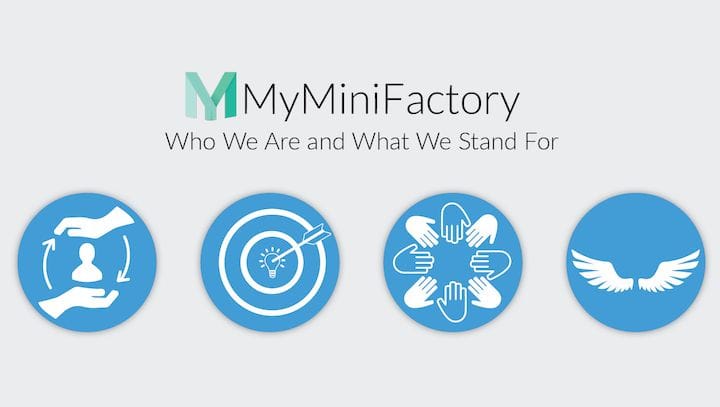![MyMiniFactory’s values [Source: MyMiniFactory]](https://fabbaloo.com/wp-content/uploads/2020/05/image-asset_img_5eb09294db535.jpg)
There seem to be some big changes unfolding at MyMiniFactory.
The London-based company is one of the few repositories dedicated to hosting truly 3D printable models for enthusiasts. Yes, there are a few other repositories, most notably the behemoth Thingiverse, which now carries almost 3.8M 3D models.
The problem with Thingiverse is that it is a relatively uncontrolled space, and contributors are free to post pretty much anything (as long as it’s legal). This results in a massive compendium of 3D models that may — or may not — be actually 3D printable. Many 3D models are on Thingiverse are in fact not printable due to orientation, wall thicknesses, pathological geometry or other factors.
Swimming through that ocean of questionable 3D models was one of the prompts that resulted in the launch of MyMiniFactory some years ago. The site started by assuring participants that each and every 3D model on the site would truly be 3D printable.
MyMiniFactory Visit
How could they ensure this? It was simple: they literally attempted to 3D print every submission. I saw this with my own eyes when I visited MyMiniFactory in 2015.
I saw dozens of staff busily working through submissions, with multiple 3D printers busily printing, well, anything that arrived. They had a lot of scrap prints, as you might imagine.
But this effort paid off, as the site rapidly became popular among enthusiasts due to its model reliability and consistency. The site also became the de facto headquarters for museum 3D scans with their “Scan the World” project.
MyMiniFactory’s work was a tremendous gift to the 3D print community, and still is. But one thing always bothered me: who is paying for all this work and services?
The site when launched did not sell any 3D models in their repository. Later I learned that they did receive some revenue through licensing deals with 3D printer manufacturers who could directly connect their device to the vast MyMiniFactory repository. This enabled some 3D printers to print models at the touch of a button.
MyMiniFactory also offered sales of 3D printers, one of which we reviewed: the BIQU Thunder. This machine, as you might guess, included the direct-to-repository feature, and we found it worked quite well.
But was that enough revenue to pay for expenses? I still wondered.
New MyMiniFactory CEO
Then we received word last month that MyMiniFactory has a new CEO, Chengxi Wang, who takes over the role from long-term CEO Romain Kidd. What happened to Kidd? They explain:
“Kidd will be taking on a new role with the organization on the Board of Directors.”
Wang is a chartered financial analyst who has been running a variety of unusual startups, and is also a musical artist, singing and playing piano.
When an organization takes on a new CEO, there are bound to be changes. That’s why the new CEO is in place. At this point, we don’t really know what the future holds as there have been no significant announcements from MyMiniFactory.
However, there has been a very curious long post on their blog that hints at changes coming. The 1500+ word post talks at length about the company’s values and how they enable the 3D print community to do its thing.
They hint at some kind of “decentralization”, and it is not clear at all what that might mean. They say:
“This is about enabling an ecosystem that thrives because of the network of cultivated tribes who’ve given so much to it. Who deserve to feel heard and valued and connected to the long term vision and mission of the community. We don’t feel we should be at the center of it all. In fact, we aim for our contribution to be a simple system of governance that focuses on the shared values of the community and what we’re all building.”
MyMiniFactory Strategy
And then this:
”It’s been a while coming to be honest with you. You know when you want to tell someone something and you sort of don’t know how? And you want it to be perfect but you’re also kind of worried about their reaction? Yeah, it’s sort of like that.
We’ve been gathering feedback, reading comments, jumping on video calls, powering through emails and internal discussions, countless meetings and even, excitingly enough, the introduction of new core members of the team. Including the recent announcement of our new Chief Executive Officer Chengxi Wang.
We’ve come to a catalyst of the dominance of central organizations. We’re realizing more and more that free comes at a cost. The cost of your personal information. We’re understanding better than ever that competition is valuable and welcomed to keep a balance of power and an interesting marketspace. We’re seeing the demise of options and sometimes rights due to large corporations owning the marketplace. We want to be a part of a future that offers greater opportunity.
Decentralization means that you as makers and designers take ownership over your experience. To grow your universe in the way you find most compelling to yourself. To be able to be true to who you are within the framework of your shared values.”
MyMiniFactory Paid Downloads?
Do you know what this means? I sure don’t. But it does hint at decentralization, privacy, and perhaps costs.
That last point is what seems to have struck a nerve with MyMiniFactory participants, as several comments raise fears of the prospect of paying for downloads. However, MyMiniFactory has officially said nothing in that regard, at least yet.
They do say they will be providing more information soon, and we’re going to be listening.
Via MyMiniFactory





